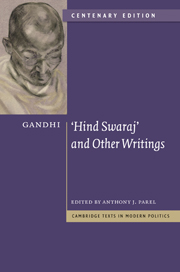Book contents
- Frontmatter
- Contents
- Preface to the centenary edition
- Acknowledgements
- Editor's introduction to the centenary edition
- Editor's introduction to the 1997 edition
- A note on the history of the text
- Principal events in Gandhi's life
- Biographical synopses
- Guide to further reading
- Glossary and abbreviations
- HIND SWARAJ
- SUPPLEMENTARY WRITINGS
- Gandhi's letter to H. S. L. Polak
- Gandhi's letter to Lord Ampthill
- Preface to Gandhi's edition of the English translation of Leo Tolstoy's Letter to a Hindoo
- Gandhi–Tolstoy letters
- Gandhi and the ‘Four Canonical Aims’ of Life (Purusharthas)
- Gandhi–Nehru dialogue
- Economic development and moral development (1916)
- Gandhi on machinery (1919–47)
- Constructive programme: its meaning and place (1941, rev. 1945)
- Gandhi's political vision: the Pyramid vs the Oceanic Circle (1946)
- Draft Constitution of Congress (1948)
- Bibliography
- Index
Gandhi and the ‘Four Canonical Aims’ of Life (Purusharthas)
Published online by Cambridge University Press: 05 October 2014
- Frontmatter
- Contents
- Preface to the centenary edition
- Acknowledgements
- Editor's introduction to the centenary edition
- Editor's introduction to the 1997 edition
- A note on the history of the text
- Principal events in Gandhi's life
- Biographical synopses
- Guide to further reading
- Glossary and abbreviations
- HIND SWARAJ
- SUPPLEMENTARY WRITINGS
- Gandhi's letter to H. S. L. Polak
- Gandhi's letter to Lord Ampthill
- Preface to Gandhi's edition of the English translation of Leo Tolstoy's Letter to a Hindoo
- Gandhi–Tolstoy letters
- Gandhi and the ‘Four Canonical Aims’ of Life (Purusharthas)
- Gandhi–Nehru dialogue
- Economic development and moral development (1916)
- Gandhi on machinery (1919–47)
- Constructive programme: its meaning and place (1941, rev. 1945)
- Gandhi's political vision: the Pyramid vs the Oceanic Circle (1946)
- Draft Constitution of Congress (1948)
- Bibliography
- Index
Summary
An updated theory of the ‘canonical aims of life’ (Purusharthas) is the general framework of Gandhi's philosophy. The good life consists in the co-ordinated pursuit of dharma (ethical integrity), artha (wealth and power, or economics and politics), kama (pleasure) and moksha (spiritual transcendence). Supporting evidence is presented below. [Ed.]
From Gandhi's Foreword to Gokhale's Speeches
Gandhi regarded Gokhale as his ‘political guru’. In the Foreword he states that the secret of Gokhale's achievements was the co-ordinated pursuit of artha, dharma and moksha. [Ed.]
In these difficult and degenerate times [kali-kal], the pure spirit of dharma is hardly in evidence anywhere. Men who go about the world calling themselves rishis, munis and sadhus rarely show this spirit in themselves. Obviously, they have no great treasure of dharma to guard …
I have not the least doubt that Gokhale was wise in the truth of the Self. He never made a show of ritual practices but his life was full of the true spirit of dharma. Every age is known to have its predominant mode of spiritual effort [pravartti] best suited for the attainment of moksha. Whenever the spirit of dharma is on the decline, it is revived through such an effort [pravartti] in tune with the times. In this age, our degradation reveals itself through our political condition. Not taking a comprehensive view of things, we run away with the belief that, if but our political conditions improved, we would rise from this fallen state. This is only partially true.
- Type
- Chapter
- Information
- Gandhi: 'Hind Swaraj' and Other Writings , pp. 139 - 142Publisher: Cambridge University PressPrint publication year: 2009

